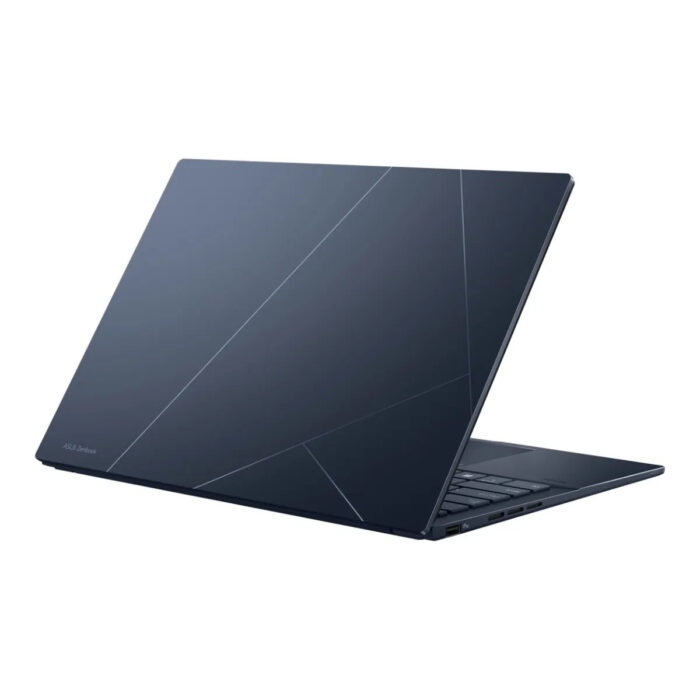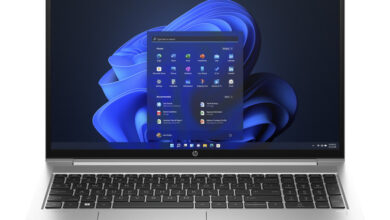When buying a new laptop, ASUS invariably emerges as a prominent contender within the realm of laptop brands. Renowned for its diverse array of notebooks spanning from entry-level to flagship models, ASUS stands as a comprehensive solution for various computing needs. Within this expansive lineup, the ASUS Zenbook series takes center stage, and today’s focus rests on the ASUS Zenbook 14 OLED – an epitome of sophistication and power within the business segment.
Equipped with the formidable Intel Core i7 Ultra 7-155H processor, this notebook asserts itself as a pinnacle of performance. Tailored not only for business professionals but also catering to the demands of basic graphics designers, the ASUS Zenbook 14 OLED UX3405 stands out with its OLED Display and cutting-edge Intel Arc Graphics—an evolutionary leap in integrated GPU technology.
Delving into its display prowess, the OLED screen transcends the ordinary, boasting a 2.8K resolution complemented by a swift 120Hz refresh rate. This harmonious blend ensures a seamless and crystal-clear visual experience, setting it apart in the business laptop landscape. The commitment to excellence extends beyond visuals, with a capacious 75WHr battery underlining endurance, coupled with the convenience of 65W fast charging. Under the hood, the ASUS Zenbook 14 OLED impresses with a lightning-fast 32 GB LPDDR5x memory, elevating multitasking to new heights. Complementing this is the inclusion of a 1TB PCIe 4.0 SSD, aligning with the industry’s preferred choice for swift data access.
ASUS Zenbook 14 OLED: Specifications
| Screen | 14.0-inch, 3K (2880 x 1800) OLED 16:10, 0.2ms, 600nits, 100% DCI-P3 color gamut, 1,000,000:1, 1.07 billion colors, Glossy, 70% less harmful blue light, SGS Eye Care Display, 87% Screen-to-body ratio |
| Processor | Intel Core Ultra 7 Processor 155H 1.4 GHz (24MB Cache, up to 4.8 GHz, 16 cores, 22 Threads); Intel AI Boost NPU |
| Wireless Connection | Wi-Fi 6E (802.11ax) (Dual band) 2*2 + Bluetooth 5.3 Wireless Card |
| Graphics card | Intel Arc Integrated Graphics |
| Memory | 32GB LPDDR5x on-board Dual-Channel Memory. |
| Storage | 1TB M.2 NVMe PCIe 4.0 SSD |
| Camera | FHD camera with IR function to support Windows Hello With privacy shutter |
| Ports | 1x USB 3.2 Gen 1 Type-A |
| Battery | 75WHrs, 2S2P, 4-cell Li-ion battery with 65W AC Adaptor |
| OS | Windows 11 Home – ASUS recommends Windows 11 Pro for business |
| Weight | 1.28 kg (2.82lbs) |
ASUS Zenbook 14 OLED UX3405: Body Design and Appearance
When we take a closer look at the ASUS Zenbook 14 OLED, it’s clear they’ve paid careful attention to the aesthetics, sticking to what’s essential for a business notebook – sleek and light. The dimensions, according to the company, come in at 312.4*220.1*14.9mm, and it weighs in at a minimal 1.28kg. It’s the kind of device that doesn’t burden you, fitting seamlessly into the demands of a professional lifestyle. With its slim profile measuring a mere 14.9mm, this notebook embodies portability at its finest. It graciously allows for one-handed handling and effortless storage in a bag, ensuring a travel companion that won’t weigh you down.

Available in two tasteful color choices—Ponder Blue and Foggy Silver—the model we’re delving into showcases its Ponder Blue variant, radiating a refined dark blue-violet tone. This color scheme, marked by its grace and subtle allure, effortlessly aligns with the discerning taste of business professionals. The exterior design of the display embraces a minimalist approach, adorned with four modest straight lines that artfully converge to shape the letter “A,” invoking a sense of simplicity and sophistication.
Upon lifting the lid, we are greeted by a 14-inch OLED Display flanked by slim side bezels, with the top bezel slightly wider to accommodate the webcam, microphone, and other sensors. Notably, the notebook embraces flexibility with a 180-degree opening capability, facilitating usage at various angles to suit diverse user preferences.

The overall design ethos of the ASUS Zenbook 14 OLED embodies simplicity and timelessness. The Ponder Blue color option, in particular, enhances the device’s classic aesthetic appeal. A standout feature is its remarkably lightweight and agile physique, akin to the delicacy of jade. This elevation in design aesthetics positions the notebook at a premium tier, ideally suited for discerning business individuals engaged in mobile office endeavors across diverse scenarios.
ASUS Zenbook 14 OLED: Display
Shifting our focus to the notebook’s display, we find a captivating 14-inch OLED display that boasts an impressive 2.8K resolution (2880*1800p) coupled with a snappy 120Hz refresh rate. The aspect ratio stands at 16:10, framed by a four-sided micro-frame design, achieving an 88% screen-to-body ratio. With a rapid 0.2ms response time, the display delivers swift and seamless visuals, while the peak brightness support maxes out at 600nits according to official specifications. It’s worth noting that the display, although lacking touch capability in its standard configuration, offers a touch-supported variant with a peak brightness of 550nits.

According to official claims, the display impressively covers a 100% DCI-P3 color gamut, showcasing 1.07 billion display colors and an outstanding 1,000,000:1 contrast ratio. The display holds notable certifications, including SGS Eye Care Display (emitting 70% less harmful blue light), TÜV Rheinland certification, and VESA CERTIFIED Display HDR True Black 600.
In our evaluation using the Spyder X software, the display demonstrated exceptional performance, covering 100% sRGB, 88.9% AdobeRGB, and 100% DCI-P3 color gamut. Particularly noteworthy is the support for four professional color gamut switching options, displaying 1 billion colors with a 10-bit color depth. In DCI-P3 color gamut mode, we conducted tests revealing an average display color deviation value of 0.57 and a maximum of 2.57, underscoring the high accuracy of its color representation.
ASUS Zenbook 14 OLED Screen Test Results |
|
| sRGB | 100% |
| Adobe RGB | 89% |
| DCI-P3 | 100% |
| Maximum Brightness | 600nits |
| Average Delta E | 0.58 |
| Maximum Delta E | 2.56 |
It’s worth highlighting that the OLED screen incorporates pixel-level compensation technology, a measure taken to prevent screen burn-in. When the notebook remains stationary for an extended period, it automatically engages ASUS’s sample video demonstration, mitigating the risk of screen burn.
ASUS Zenbook 14 OLED: Keyboard and TouchPad
Adjacent to the vibrant display, the ASUS Zenbook 14 OLED houses a Backlit Chiclet Keyboard that, while missing a numeric pad, proves understandable given the compact size of the notebook. Such omission is commonplace in 14-inch display notebooks, and here, it seems a practical design choice. The entire keyboard surface adopts a uniform deep blue color, with keys featuring a slightly lighter shade. The keys’ travel distance is a modest 1.4mm, rendering a pleasantly hushed typing experience—devoid of the usual clatter. Notably, the keyboard supports a single-light backlit feature, enhancing visibility in varied lighting conditions.

Beneath the display, a generously sized touchpad takes center stage, flaunting a sunken design accentuated by high-gloss rounded chamfers, elevating its prominence within the laptop’s aesthetic. The ample touchpad area facilitates seamless navigation, contributing to an overall smooth user experience.
An interesting design choice emerges in the differentiation between the keyboard area and the touchpad plane. This intentional contrast injects a sense of variety into the overall aesthetics, preventing monotony and adding a nuanced visual appeal to the notebook’s design.
ASUS Zenbook 14 OLED: Ports
To achieve the slim profile of the laptop, ASUS has made some strategic compromises in the ports department. The ASUS Zenbook 14 OLED boasts a total of five ports, with four situated on the right side and the remaining one on the left. On the right side, users will find 2x Thunderbolt 4 Type-C ports (with Display and Power Delivery support), a 3.5mm headphone jack, and an HDMI 2.1 port. Meanwhile, on the left side, there’s a lone USB 3.2 Type-A Gen1 port.

Noteworthy is ASUS’s inclusion of a USB-A to RJ45 Gigabit Ethernet Adapter, a thoughtful addition that enables users to connect a LAN cable for faster internet speeds. While the provided ports cater well to the demands of daily office use, those with more extensive connectivity requirements may find value in opting for a USB dock to expand their port options.
ASUS Zenbook 14 OLED: Battery and Charging
In the realm of battery life, the ASUS Zenbook 14 OLED draws power from a robust 75WHr 4-cell Li-ion (9,420mAh rated capacity) battery—an optimal capacity for a 14-inch OLED notebook. According to official specifications, this battery is touted to endure beyond 15 hours under normal usage conditions.
To validate this claim, we conducted a battery test, playing a local video with the screen brightness set at 80% and the volume at 40%. After nearly two and a half hours of playback, the battery capacity stood at a commendable 80%, attesting to the notebook’s satisfactory battery performance.
In terms of charging, ASUS equips the Zenbook 14 OLED with a 65W (20V/3.25A) Type-C Adaptor. This adapter facilitates rapid charging, enabling a swift replenishment of 60% battery capacity in just 45 minutes. The versatility of the Thunderbolt 4 USB-C Easy port further enhances the charging experience, offering convenience and efficiency.
ASUS Zenbook 14 OLED: RAM and SSD
Turning our attention to the memory configuration and storage capabilities of the notebook, the variant under review is equipped with a robust 32GB LPDDR5X Dual-Channel memory, boasting an impressive 7467 MT/s speed. It’s worth noting that the RAM is soldered onto the motherboard and cannot be upgraded beyond the 32GB threshold. However, for those with budget constraints or more modest requirements, alternate configurations with 8GB and 16GB of RAM are also available. The high-speed LPDDR5-7467 RAM ensures seamless performance even under heavy usage scenarios.
Moving on to storage, the notebook presents two options, with the reviewed model featuring a capacious 1TB M.2 NVMe PCIe 4.0 SSD. It’s important to mention that the notebook accommodates only one SSD slot, meaning any storage upgrades would involve a replacement of the existing SSD.
For evaluating the SSD’s performance, we employed the CrystalDiskMark benchmark application, yielding the following results: 5,005 MB/s Sequential Read Speed, 3,545 MB/s Sequential Write Speed, 43 MB/s 4K Random Read Speed, and 81 MB/s 4K Random Write Speed. These benchmark figures underscore the commendable performance delivered by the SSD, affirming its capability to meet the demands of various computing tasks.
ASUS Zenbook 14 OLED: CPU and its Benchmark
The ASUS Zenbook 14 OLED is propelled by the cutting-edge Intel Core Ultra 7-155H CPU, marking its inclusion in the inaugural batch of notebooks featuring this powerhouse processor. Employing the latest Intel 4 process and incorporating EUV extreme ultraviolet lithography, this CPU stands out with a 20% boost in performance and improved power efficiency compared to its predecessor, the Intel 7. Featuring a formidable configuration with 16 cores (including 6 Performance Cores, 8 Energy-Efficient Cores, and 2 Low-Power Energy-Efficient Cores), 22 threads, and a substantial 24MB L3 cache memory, this CPU achieves a peak frequency of 4.8GHz with a TDP of 28W.
Worth highlighting is the availability of alternative CPU options for the ASUS Zenbook 14 OLED, including the Intel Core Ultra 5-125H CPU and the Intel Core Ultra 9-185H CPU.
Moreover, the CPU integrates the Intel Arc Integrated GPU, boasting an 800MHz core frequency and nearly double the performance of its predecessors in integrated GPUs. It supports impressive features like 8K 10-bit HDR and the AV1 codec. Leveraging FOVEROS 3D packaging technology and a modular design, this CPU incorporates a built-in artificial intelligence NPU, achieving an 8-fold improvement in artificial intelligence efficiency, thereby empowering AI acceleration. In essence, the Core Ultra series processors embrace the latest technological advancements, promising noteworthy enhancements in energy consumption ratios. A significant leap forward, indeed.
For testing the CPU and its integrated GPU, we did some benchmark tests, which are the following:
Cinebench R20: 689cb on Single Core and 5,459cb on Multi-Core
Cinebench R23: 1,796pts on Single-Core and 14,067pts on Multi-Core
CPU-Z: 697.1 points on Single Thread and 7,128.3 points on Multi Thread
The following are integrated GPU’s benchmarks:
3DMark Time Spy: 3,691 points
3DMark Wild Life Extreme: 7,035 points
The performance of the ASUS Zenbook 14 OLED’s CPU has proven to be highly commendable, surpassing benchmarks when compared to other notebooks within the business segment. Furthermore, the GPU’s capabilities are strikingly comparable to the GTX 1650, a robust graphics card known for handling demanding applications and tasks with ease. This synergy between a powerful CPU and a GPU akin to the GTX 1650 positions the Zenbook 14 OLED as a compelling choice for users seeking performance excellence, especially in scenarios involving resource-intensive applications and tasks.
ASUS Zenbook 14 OLED: Heat Dissipation
In prioritizing effective heat dissipation, ASUS has strategically integrated numerous ventilation ports into the design of the ASUS Zenbook 14 OLED. The underside of the notebook is adorned with an array of ventilation ports, ensuring optimal airflow for temperature regulation. On the left side, following the singular USB Type-A port, three additional ventilation ports contribute to the cooling system.
Upon disassembling the notebook, it becomes evident that ASUS has implemented a singular cooling fan and a dual heat pipe configuration, showcasing a thoughtful approach to thermal management.
Throughout our extensive benchmark tests, temperature measurements were conducted to assess the notebook’s thermal performance. The highest observed temperature reached 39.1°C at the upper-middle section of the keyboard area. Notably, the noise emitted by the cooling fan remained at a minimum level, ensuring that user comfort was not compromised. The thoughtful combination of ventilation design and efficient cooling components contributes to maintaining an optimal operating temperature without sacrificing a tranquil user experience.
Also Read: HP Pavilion Plus 16 (2023) Review
Summary:
The ASUS Zenbook 14 OLED UX3405, a flagship in the business segment, boasts an Intel Core i7 Ultra 7-155H processor, catering to both professionals and basic graphics designers. Its standout features include a 2.8K OLED display with a 120Hz refresh rate, a 75WHr battery with 65W fast charging, 32GB LPDDR5x memory, and a 1TB PCIe 4.0 SSD. The slim and lightweight design in Ponder Blue adds elegance, complemented by a thoughtful keyboard and touchpad. Despite limited ports for its slim profile, it covers daily office needs. Excellent heat dissipation, powered by a dual heat pipe system, maintains efficient thermal management with minimal fan noise, reaching a maximum of 39.1°C. The Intel Core Ultra 7-155H CPU, coupled with an integrated GPU comparable to a GTX 1650, ensures stellar performance. Priced at $1200 (for the variant we reviewed in this article), the ASUS Zenbook 14 OLED UX3405 offers a well-rounded package for business and creative professionals.





